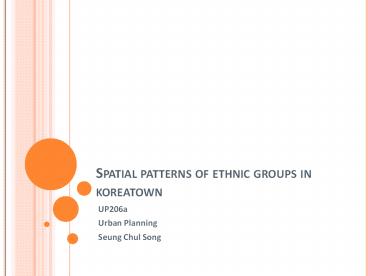Spatial%20patterns%20of%20ethnic%20groups%20in%20koreatown - PowerPoint PPT Presentation
Title:
Spatial%20patterns%20of%20ethnic%20groups%20in%20koreatown
Description:
SPATIAL PATTERNS OF ETHNIC GROUPS IN KOREATOWN UP206a Urban Planning Seung Chul Song Add Background color for Legend Add street names Use percentage instead of total ... – PowerPoint PPT presentation
Number of Views:227
Avg rating:3.0/5.0
Title: Spatial%20patterns%20of%20ethnic%20groups%20in%20koreatown
1
Spatial patterns of ethnic groups in koreatown
- UP206a
- Urban Planning
- Seung Chul Song
2
- Koreatown in the City of Los Angeles has been a
meaningful place for Korean immigrants and
visitors from Korea. It is the largest Korean
Community outside of Korea. - The demography of Koreatown is changing.
According to SCAG Region Compass Blueprint Case
Study, Koreatown is home to concentrations of
ethnicities other than Korean Americans,
including Hispanic, Chinese, Japanese, Filipino,
Bangladeshian and other Asian Americans.
3
Koreatown, Little bangladesh get actural borders
4
Mapping Plan
- Phase I
- Identify boundary of Koreatown
- Identify ethnicity in Koreatown
- Analyze the spatial patterns for different users
groups
- Phase 2
- Identify open space in Korea town
- Identify transportation mode as a way to connect
open space - Conclusion
5
(No Transcript)
6
(No Transcript)
7
Ethnicity
The percentages of Asian and Latino people are
high for the county. Highly diverse for the city
of Los Angeles and highly diverse for the county
8
Space use by Ethnicity
Asian
Hispanic
9
Zoning map and Ethnicity
There is a relationship between Zoning and
spatial pattern of Ethnic groups. Hispanics live
northeast of the major commercial area (map on
the left) but few individuals live near the
commercial area (refer to ethnicity
map). Therefore, we can conclude that the
commercial area is Korean dominated.
10
Spatial Pattern
- Korean Restaurants
- Mexican Restaurants
- Bangladesh Facilities
11
Buffer Zones
12
Where is a opportunity spot for ethnic fest?
Currently, Open spaces are on the edge of
Koreatown. There is no space where different
ethnic groups can celebrate together .Thus it is
likely to be used by certain ethnic group.
13
Percentage of Public Transportation users
It is necessary to change routes of existing
public transportation or implement new
transportation system
14
Suggestion fixed guide rail system
15
Potential route for new transportation
New transportation can be a circulative loop that
connects cultural centers of each ethnicity.
16
(No Transcript)
17
(No Transcript)
18
Findings
- The boundary defined by census does not match
with actual spatial use in Koreatown. - Each ethnic group forms its own spatial boundary
and tends to gather around space associated with
each culture.
Conclusion
- There is no central open space where different
ethnic groups can celebrate together. - It is required to change current public
transportation routes or implement new system in
order to make closed loop for each community
centers.
19
GIS skills used to create layouts
- Inset map(p5)
- Point or line graduate symbol(p6,8,9,10,11)
- Aggregating attribute fields(p7)
- Attribute sub-sets selections(p6,p13)
- Boundary sub-sets selections(p6)
- Buffering(p11)
- Geo-processing(p6)
- Geo-coding(p10)
- Spatial Analyst(p13)
- Network Analyst(p15)































